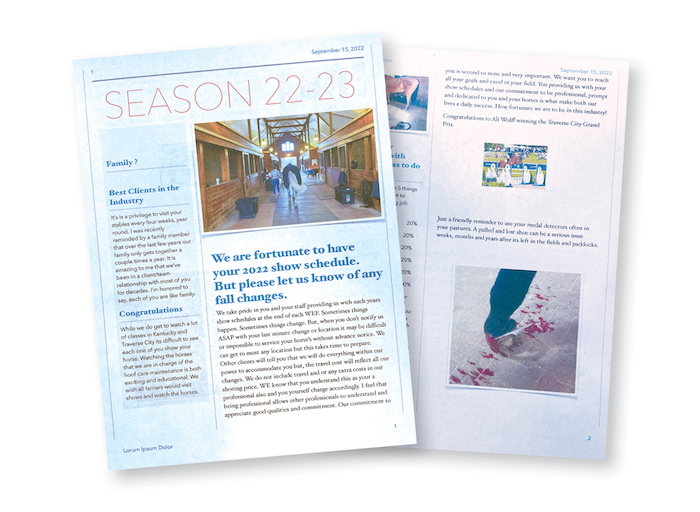Dave Farley, a farrier based in Wellington, Fla., started a practice decades ago to improve farrier-client communication and understanding. In the 1980s, he began sending his clients a yearly newsletter in early January. The contents of this newsletter could include product usage changes, tips for properly cleaning hoofs or life/business updates, but uniquely, the newsletter also included the price changes Farley was going to enact for the coming year for his services.
“The cost of living goes up every year,” says Farley, a 2008 inductee of the International Horseshoeing Hall of Fame. “We shouldn’t have to absorb that. I have always tried to let the clients know what our profit margin is and that it is adjusted each year. Out of goodwill to all, I have only increased costs to maintain the same level of profit each year. The prices only go up as much as the cost of living, materials and other expenses.”
Farley says that he had never been challenged on his price increases by clients when he puts the information in his yearly newsletter. He maintains that it is vital for farriers to inform their clients of these charges and changes, as that will educate them on the life and business of the farrier.
Client education can be a double-edged sword, however. With the introduction of massive online repositories of information and easy-to-use search engines, Farley says that it can be difficult to maintain your status as an expert in the field. His newsletter helped him accomplish just that.
“Clients are always getting pitches for products and services, but often they aren’t even told how to use it,” Farley says. “I find it enlightening that they call me to ask if there’s any value in the product or service. Some of it is fine advice, and clients are always going to have something they’ll ask questions about. I was fortunate enough to have started educating my clients early on, and that’s why I still have some of them 30 years later.”
People with integrity usually make the best decisions and they have the best results …
Research shows that email marketing and newsletters are still one of the most effective methods for updating your clients about your business. Even with the onset of social media, most consumers still tend to prefer email in regard to their marketing consumption.
But there are other tactics and traits Farley recommends for maximum client retention.
“I always say there are three things a farrier needs to be successful: integrity, intelligence, and energy,” he says. “The most important is integrity.”
Farley adds that, in his experience, individuals with integrity tend to make the best choices in their personal and professional lives and they maintain positive relationships and habits, which leads to success. He says that even the simplest of tasks, like showing up on time, showcases the farrier’s integrity, energy and intelligence.
“Your positive habits affect everyone around you, and so do your negative habits,” says Farley. “Build on those habits and improve the relationships you have with clients, horses and your business itself.”
Farley says sending yearly newsletters helps him build integrity and trust with the client, as they will know what to expect in the coming year.
Managing Clients While Maintaining Integrity
Farley says that while many beginning farriers will just take any client that they can early in their career, don’t be afraid to let a client go as your business grows.
“As you reach your income potential with that client or discipline, think about opportunities to replace the client, should the option arise,” says Farley. “But keep this in mind: don’t burn a bridge with your clients. You never know when the client will call you and ask if there is any chance I could get you back?”
Farley says that it is best practice to try to turn the client over to another farrier who was in a similar position when you took on the client. But Farley cautions farriers to look out for warning signs when working with clients.
“There are a lot of warning signs for clients and farriers; not respecting your time or work, having bad habits, always on the phone,” says Farley.
One of his warning signs comes from his clients’ willingness to be educated. Farley always provides his prospective clients with a list of his expectations for the client, horse and job, and also what basics he will need in order to properly shoe the horse. These include simple requirements like a dry, flat area to shoe and a place where he can have illumination to see his work.
Your positive habits affect everyone around you …
“I always give clients a print out of my principles for shoeing and how we can achieve success in caring for the horses. If they don’t look at that piece of paper, that’s a warning sign for me,” says Farley.
He continues that one of the biggest complaints farriers and clients have about each other is that one or both parties have a tendency to be tardy.
“Just like a horseshoer, the same negative qualities show up in owners, too,” he says, adding he stresses this in his principles.
Look to the Future
It’s important for farriers to be proactive in their shoeing business, as well, Farley says. “Watch for something coming down the road,” he says. “If I get under a horse and its front leg can’t extend forward enough to reach the hoof stand, I will make a note of it in their bills, along with verbally telling the owners or other handlers about the problem. I want the person in charge of the horse to know about any issue.”
Farley adds that this practice re-ceives a lot of praise from clients. “You would be surprised how many ‘thank yous’ I’ve received from clients because they may call in a veterinarian based on my assessment. At the very least, if they go see a vet about the problem, the client will have an understanding of how long the issue has been occurring, and maybe even an idea of what it is,” says Farley.
He continued that by telling horse owners about these issues, he builds his level of trust with clients and maintains his integrity.
LEARN MORE
Gain more insight about effective client communications by:
- Watching “Better Business and Financial Insight” online classroom.
- Reading “Explaining Your Expenses Can Educate Clients About Footcare Costs.”
- Reading “Use a Newsletter to Educate Your Clients.”
You can access this exclusive content by visiting AmericanFarriers.com/1122
“I don’t list everything I think I use on or do for the horse,” Farley says. “I keep mental notes of that, but it doesn’t go on the invoice for the client to see or to show others.”
As the adage goes, “your word is your bond,” and Farley holds true to that, which in turn bolsters his commitment to his clients and his business.
“When you s et a policy, sometimes you’re going to lose a client, and that’s usually the client that you’ve had difficulty with before,” says Farley. It does not matter if the difficulty stems from a problem with payment or if there is some other issue with the client, the policy is the policy. Keeping to that policy, Farley reasons, will also develop your sense of integrity.
“People with integrity usually make the best decisions and they have the best results in business,” Farley says.

Tips for Managing Your Cash Flow
In recent years, Florida farrier Dave Farley has implemented a new policy into his shoeing business: no cash payments and no checks. Farley says that he used to allow cash or checks, and received many promises of payment over the years, but was burned too many times. He says that about 20% of his clients have adopted the online payment method, instead of credit cards.
“For some reason in the jumper industry right now, Venmo is working well,” says Farley. He says it is a good way to get your money before you leave the barn, and ensures everyone is holding up their end of the bargain.
“All farriers need a policy of what’s expected for payment. Don’t just show up without a policy. It will catch up to you and you will be left short,” he says. “But what type of payment you accept is up to you.”
Farley also mentions that he will tack the small transaction fee of using credit cards or Venmo onto the bill, so that he does not have to eat it as the farrier.
“Most good credit card companies are 3% or less, and Venmo is about the same,” Farley says.
He says that the choice of including these transaction fees on the customers final bill is a decision at the discretion of the business owner, in this case the farrier. Farley also offered additional advice for traveling farriers, no matter the miles traveled.
“I charge for my travel time,” he says. “I let the clients know that my time starts when I close my door to leave and it ends when I open it to go back home. I put all of my travel expenses and time included on my invoices.”
As long as he’s discussed these policies with clients before shoeing their horses, Farley has never been challenged on the topic. Farley says that even when there is a miscommunication, the trick is to explain the extra cost to the client and illustrate that this is a company policy.
“Once you explain it to them, they’re OK,” Farley says.









Post a comment
Report Abusive Comment